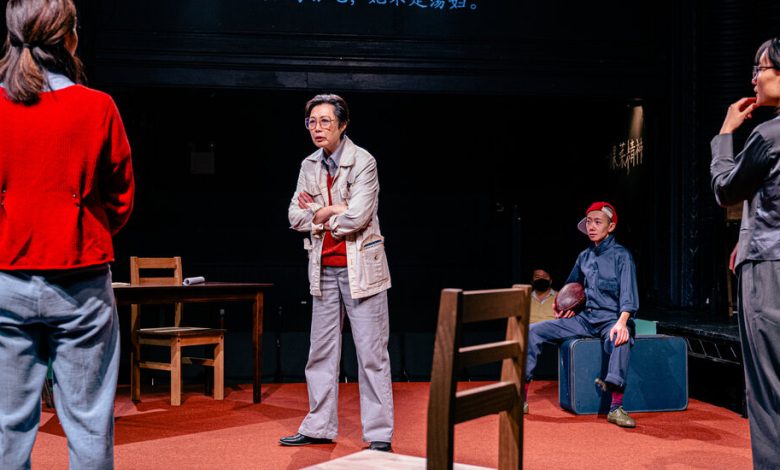A Play Revisits the Making of ‘Death of a Salesman’ in Mandarin

In 1983, Arthur Miller faced a herculean task: staging his 1949 Pulitzer Prize-winning play, “Death of a Salesman,” in Chinese, with an all-Chinese cast and crew, in Beijing.
But questions kept popping up: Would this drama about the American dream translate for a Chinese audience? Would concepts like “traveling salesman” or “life insurance” make sense to a people who had little exposure to either?
Rehearsals became exercises in cross-cultural exchange. At one point, Miller instructed his cast to abandon the wigs — he didn’t need them to impersonate Americans.
“The way to make this play most American is to make it most Chinese,” he told them, according to his 1984 book about the undertaking, “Salesman in Beijing.” He added, “One of my main motives in coming here is to try to show that there is only one humanity.”
The play eventually drew rapturous audiences to dozens of performances in Beijing, Hong Kong and Singapore, and was a watershed for U.S.-China cultural relations.
Forty years later, the process of staging that production is the subject of the Off Broadway play “Salesman之死,” running through Oct. 28 at the Connelly Theater in the East Village. (The 之死 of the title, pronounced Zhisi, means “death of.”) Directed by Michael Leibenluft and written by Jeremy Tiang, the bilingual play centers on a young Chinese professor, Shen Huihui, who interprets for Miller during rehearsals, trying to translate for the cast ideas like “the American dream.”
By spotlighting the linguistic and cultural misunderstandings between the American playwright and his Chinese collaborators, the new play explores the challenging dynamics that arose when the two cultures converged.
“This play is an example of international cross-cultural collaboration I fear we don’t see enough of,” Tiang said during a video call. “What would happen if we did try to find a way to work together, rather than just sticking to our own patch of language and culture?”
Tiang drew on interviews with the original production’s cast and crew, as well as the book in which Miller recounts traveling to China at the invitation of Ying Ruocheng, one of China’s leading actors and directors, and the playwright Cao Yu.
China had only recently emerged from its Cultural Revolution — the Maoist movement that targeted intellectuals and resulted in the deaths of hundreds of thousands of people — and its government had adopted a new foreign policy of openness to the West. Artistic projects once unthinkable under Mao Zedong suddenly become achievable.
The real-life Shen Huihui was among the first group of students to attend graduate school after the Cultural Revolution. At Peking University, Shen wrote her dissertation about Miller’s books and plays and published one of the first journal articles about Miller in Chinese. When Miller arrived in China to direct “Salesman,” Ying, who translated the script and played the protagonist, Willy Loman, asked Shen to be the rehearsal interpreter.
“I was shocked,” Shen said in a recent phone interview. “Why me? There were plenty of people who were professional interpreters, and I was not a professional interpreter.”
Meeting Miller was both thrilling and intimidating, said Shen, who now lives and teaches writing in Canada. She recalled a tall, broad-shouldered man who seldom smiled.
Rehearsals started in March and by opening night on May 7, Miller and his collaborators had worked through numerous adjustments (and endured many a misunderstanding) on the way to staging this tale about the perils of the American dream.
Those cross-cultural encounters are the core of “Salesman之死,” which is being produced by Yangtze Repertory Theater in association with Gung Ho Projects; much of the play’s plot centers on the bilingual and often chaotic exchanges within the 1983 rehearsal room.
Leibenluft first read “Salesman in Beijing” as an undergraduate studying theater and Chinese at Yale University. He later moved to Shanghai and began directing adaptations of American plays in China.
In 2017, he hosted a workshop to explore possibilities for turning “Salesman in Beijing” into a play. Tiang was among the writers and directors who attended, and he soon started writing a script.
The show eventually opted for an all-female cast, which “highlights the women who are part of this history and who are often overlooked,” Leibenluft said on a video call.
On a recent Thursday, cast members huddled around a table in a rehearsal room in Midtown Manhattan. (Five of the six actors are immigrants from China and Taiwan and are fluent in English and Chinese.) Sonnie Brown, a Korean American actor who plays Arthur Miller, barked out instructions, while Jo Mei, who plays Shen Huihui, translated them into Chinese. (The show, in English and Mandarin, has supertitles in both languages.)
The play is “so hopeful,” Mei said, describing it as a reminder of people’s common humanity: Everyone, whether Willy Loman or a shopkeeper in China, suffers the same disappointments, shares the same dreams.
“It says so much about how as different as you think you are, the themes and humanity are so similar and universal,” she said. “The more different or specific, the more universal is what I think Miller and Ying were trying to get at.”



